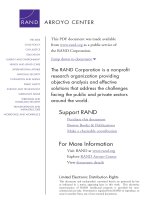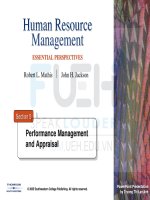Dessler HRM 12e ch 09 performance management and appaisal
Bạn đang xem bản rút gọn của tài liệu. Xem và tải ngay bản đầy đủ của tài liệu tại đây (1.44 MB, 50 trang )
Chapter 9
Performance
Management
and Appraisal
Part Three | Training and Development
Copyright © 2011 Pearson Education, Inc.
publishing as Prentice Hall
PowerPoint Presentation by Charlie Cook
The University of West Alabama
WHERE WE ARE NOW…
Copyright © 2011 Pearson Education, Inc. publishing as Prentice Hall
9–2
LEARNING OUTCOMES
1. Define performance management and discuss how it
differs from performance appraisal.
2. Set effective performance appraisal standards.
3. Describe the appraisal process.
4. Develop, evaluate, and administer at least four
performance appraisal tools.
5. Explain and illustrate the problems to avoid in
appraising performance.
6. Discuss the pros and cons of using different raters to
appraise a person’s performance.
7. Perform an effective appraisal interview.
Copyright © 2011 Pearson Education, Inc. publishing as Prentice Hall
9–3
Basic Concepts in
Performance
Management and Appraisal
Performance Appraisal
Performance
Management
Setting work
standards, assessing
performance, and
providing feedback to
employees to
motivate, correct, and
continue their
performance.
An integrated
approach to ensuring
that an employee’s
performance supports
and contributes to the
organization’s
strategic aims.
Copyright © 2011 Pearson Education, Inc. publishing as Prentice Hall
9–4
FIGURE 9–1
Online Faculty
Evaluation Form
Copyright © 2011 Pearson Education, Inc. publishing as Prentice Hall
9–5
Defining the Employee’s
Goals and Work Standards
Guidelines for Effective
Goal Setting
Set
SMART
goals
Assign
specific
goals
Assign
measurable
goals
Copyright © 2011 Pearson Education, Inc. publishing as Prentice Hall
Assign
challenging/
doable goals
Encourage
participation
9–6
Setting SMART Goals
• Specific, and clearly state the desired results.
• Measurable in answering “how much.”
• Attainable, and not too tough or too easy.
• Relevant to what’s to be achieved.
• Timely in reflecting deadlines and milestones.
Copyright © 2011 Pearson Education, Inc. publishing as Prentice Hall
9–7
An Introduction to Appraising
Performance
Why Appraise Performance?
1
Is basis for pay and promotion decisions.
2
Plays an integral role in performance management.
3
Helps in correcting deficiencies and reinforcing good
performance.
4
Is useful in career planning.
Copyright © 2011 Pearson Education, Inc. publishing as Prentice Hall
9–8
(Un)Realistic Appraisals
• Motivations for Soft Appraisals
The fear of having to hire and train someone new.
The unpleasant reaction of the appraisee.
An appraisal process that’s not conducive to candor.
• Hazards of Soft Appraisals
Employee loses the chance to improve before being
discharged or forced to change jobs.
Lawsuits arising from dismissals involving inaccurate
performance appraisals.
Copyright © 2011 Pearson Education, Inc. publishing as Prentice Hall
9–9
Performance Appraisal Roles
• The Supervisor’s Role
Usually do the actual
appraising
Must be familiar with basic
appraisal techniques
Must understand and
avoid problems that can
cripple appraisals
Must know how to conduct
appraisals fairly
Copyright © 2011 Pearson Education, Inc. publishing as Prentice Hall
9–10
Performance Appraisal Roles
(cont’d)
• The HR Department’s Role
Serves a policy-making and advisory role.
Provides advice and assistance regarding the
appraisal tool to use.
Trains supervisors to improve their appraisal
skills.
Monitors the appraisal system effectiveness
and compliance with EEO laws.
Copyright © 2011 Pearson Education, Inc. publishing as Prentice Hall
9–11
Effectively Appraising Performance
Steps in Appraising Performance
1
Defining the job and performance criteria
2
Appraising performance
3
Providing feedback session
Copyright © 2011 Pearson Education, Inc. publishing as Prentice Hall
9–12
Designing the Appraisal Tool
• What to Measure?
Work output (quality and quantity)
Personal competencies
Goal (objective) achievement
• How to Measure?
Generic dimensions
Actual job duties
Behavioral competencies
Copyright © 2011 Pearson Education, Inc. publishing as Prentice Hall
9–13
Performance Appraisal Methods
Appraisal Methodologies
1
Graphic rating scale
6
Narrative forms
2
Alternation ranking
7
Behaviorally anchored rating
scales (BARS)
3
Paired comparison
8
Management by objectives (MBO)
4
Forced distribution
9
Computerized and Web-based
performance appraisal
5
Critical incident
10
Merged methods
Copyright © 2011 Pearson Education, Inc. publishing as Prentice Hall
9–14
FIGURE 9–2
Sample Graphic
Rating Performance
Rating Form
Copyright © 2011 Pearson Education, Inc. publishing as Prentice Hall
9–15
FIGURE 9–3
One Item from an Appraisal Form Assessing Employee
Performance on Specific Job-Related Duties
Copyright © 2011 Pearson Education, Inc. publishing as Prentice Hall
9–16
FIGURE 9–4
Appraisal Form for Assessing Both Competencies and Specific Objectives
Copyright © 2011 Pearson Education, Inc. publishing as Prentice Hall
9–17
FIGURE 9–4 Appraisal Form for Assessing Both Competencies and Specific Objectives (cont’d)
Copyright © 2011 Pearson Education, Inc. publishing as Prentice Hall
9–18
FIGURE 9–5
Scale for Alternate Ranking of Appraisee
Copyright © 2011 Pearson Education, Inc. publishing as Prentice Hall
9–19
FIGURE 9–6
Ranking Employees by the Paired Comparison Method
Note: + means “better than.” - means “worse than.” For each chart, add up
the number of +’s in each column to get the highest ranked employee.
Copyright © 2011 Pearson Education, Inc. publishing as Prentice Hall
9–20
TABLE 9–1
Examples of Critical Incidents for Assistant Plant Manager
Continuing Duties
Targets
Critical Incidents
Schedule production
for plant
90% utilization of
personnel and machinery
in plant; orders delivered
on time
Instituted new production
scheduling system; decreased
late orders by 10% last month;
increased machine utilization in
plant by 20% last month
Supervise procurement Minimize inventory costs
of raw materials and
while keeping adequate
on inventory control
supplies on hand
Let inventory storage costs rise
15% last month; over-ordered
parts “A” and “B” by 20%; underordered part “C” by 30%
Supervise machinery
maintenance
Instituted new preventative
maintenance system for plant;
prevented a machine breakdown
by discovering faulty part
No shutdowns due
to faulty machinery
Copyright © 2011 Pearson Education, Inc. publishing as Prentice Hall
9–21
FIGURE 9–7
Appraisal-Coaching
Worksheet
Copyright © 2011 Pearson Education, Inc. publishing as Prentice Hall
9–22
Behaviorally Anchored Rating Scale
(BARS)
Developing a BARS
Advantages of BARS
1. Write critical incidents
A more accurate gauge
2. Develop performance
Clearer standards
dimensions
3. Reallocate incidents
4. Scale the incidents
Feedback
Independent dimensions
Consistency
5. Develop a final
instrument
Copyright © 2011 Pearson Education, Inc. publishing as Prentice Hall
9–23
FIGURE 9–8
Example of a
Behaviorally
Anchored Rating
Scale for the
Dimension
Salesmanship Skills
Copyright © 2011 Pearson Education, Inc. publishing as Prentice Hall
9–24
Management by Objectives (MBO)
• A comprehensive and formal organizationwide
goal-setting and appraisal program requiring:
1. Setting of organization’s goals
2. Setting of departmental goals
3. Discussion of departmental goals
4. Defining expected results (setting individual goals)
5. Conducting periodic performance reviews
6. Providing performance feedback
Copyright © 2011 Pearson Education, Inc. publishing as Prentice Hall
9–25









